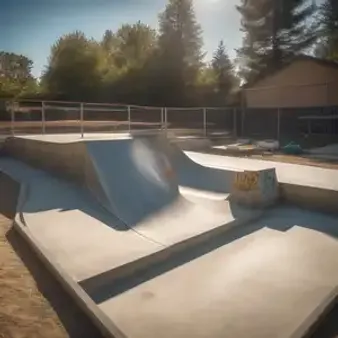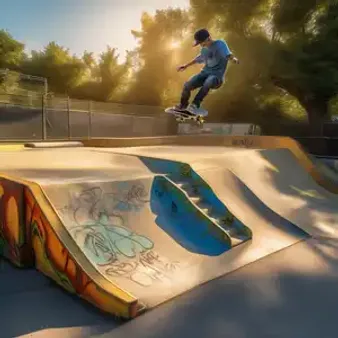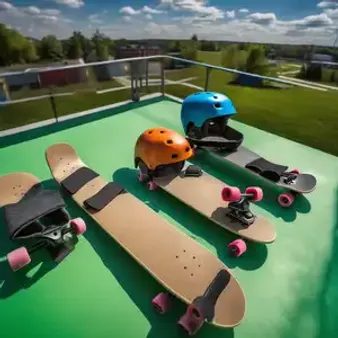Table of Contents
Ever dreamed of having your own personal skate park right outside your door? Imagine practicing your latest tricks whenever inspiration strikes, without having to travel to a crowded skatepark. At kizworld, we're here to help you turn that dream into a reality. Building an at-home skate park is an exciting project that can provide endless hours of fun and improvement for skating enthusiasts of all levels.
Feature | Description | Considerations |
|---|---|---|
Location | Choose a flat, well-drained area with ample space. | Sunlight, proximity to the house, and neighborhood regulations. |
Size | Determine the dimensions based on your skill level and available space. | Start small and expand as your skills progress. |
Surface | Smooth concrete is ideal for optimal performance. | Consider weather resistance and maintenance requirements. |
Ramps | Customize the size, shape, and angles to suit your preferences. | Start with beginner-friendly ramps and gradually increase difficulty. |
Rails and Boxes | Add grinding elements for more challenging tricks. | Choose sturdy materials and secure them properly. |
Safety Gear | Always wear a helmet, pads, and appropriate footwear. | Inspect gear regularly for wear and tear. |
Planning Your AtHome Skate Park
First things first, you gotta have a plan! It's like building with LEGOs - you wouldn't just start sticking bricks together without an idea, right? Think about what you want to do in your skate park. Do you love catching air on ramps? Or maybe grinding on rails is more your style? Check out some guides on grinds to see what I mean! Once you know what you want, measure your space. You wouldn't want a ramp that's too big for your yard! Sketch out your ideas on paper. It doesn't have to be perfect, just a rough plan to get you started.
Element | Size Guide |
|---|---|
Mini Ramp | Start with 6ft wide, 3ft tall |
Grind Rail | 2-3ft long for beginners |
Funbox | 4ft long, 2ft wide, 1ft high is a good start |
Don't forget to think about things like sunlight and drainage. You don't want your park turning into a swamp after it rains! And remember, you can always start small and add more features later as your skills grow. Think of it like a video game - you level up and unlock new areas!
Planning Your AtHome Skate Park
Building Your AtHome Skate Park: Materials and Construction
Alright, you've got your killer plan, now let's talk about bringing it to life! Building a skate park is like putting together a giant puzzle, but instead of tiny pieces, we're talking wood, concrete, and maybe even some metal. Don't worry, it's not as scary as it sounds!
First up, the surface. Smooth concrete is like the holy grail of at-home skate parks. It's durable, weather-resistant, and gives you that sweet, sweet roll. You can find pre-made concrete slabs at most home improvement stores, or if you're feeling extra handy, you can mix and pour your own. Just make sure it's super smooth – no one wants their wheels getting caught on bumps!
Choosing the Right Materials
Now, for the fun part – the ramps, rails, and boxes! You can buy pre-made obstacles, which is super convenient, or you can channel your inner Bob the Builder and construct your own. If you're going the DIY route, plywood is your best friend. It's strong, relatively inexpensive, and you can cut it into all sorts of shapes and sizes. Check out some inspiration for skate ramps to get your creative juices flowing! Just remember, safety first! Always use sturdy supports and screws, and don't be afraid to ask a grown-up for help with the power tools.
- Wood (Plywood, 2x4s)
- Concrete (Pre-mixed or mix your own)
- Metal (For rails and coping, optional)
- Screws (Heavy-duty)
- Concrete Fasteners (If attaching wood to concrete)
Putting It All Together
Once you've gathered your materials, it's time to start building! This is where your awesome plan comes in handy. Lay everything out in your designated skate park area, just like you drew it up. If you're building ramps, make sure the transitions (the curved parts) are nice and smooth – no one wants to catch an edge and go flying! Use a level to ensure everything is, well, level, and double-check all your supports and screws are in tight. You want your skate park to be rock-solid, ready to withstand even your most epic tricks! Remember, building an at-home skate park is a marathon, not a sprint. Take your time, don't be afraid to experiment, and most importantly, have fun!
Construction Step | Tips |
|---|---|
Preparing the Ground | Level the ground, remove debris, and consider a layer of gravel for drainage. |
Building Ramps | Use sturdy supports, ensure smooth transitions, and cover with a smooth surface like plywood or Skatelite. |
Installing Rails and Boxes | Anchor securely to the ground, use smooth metal for grinding surfaces, and consider adding coping for a more authentic feel. |
Building Your AtHome Skate Park: Materials and Construction
Essential Features For Your AtHome Skate Park
Now, let's talk about the heart of your at-home skate park – the features! This is where you can really let your creativity run wild. Think about what gets your adrenaline pumping. Is it the feeling of weightlessness as you launch off a ramp? Then you gotta check out these awesome skate ramps for inspiration! Or maybe you're all about grinding and sliding like a skateboarding superhero? Time to brainstorm some rails and boxes! Remember that table we made earlier about planning your park? Keep those dimensions in mind as you design your features. You don't want to end up with a ramp that takes up your whole backyard!
Feature | Description | Skill Level |
|---|---|---|
Quarter Pipe | A curved ramp that launches you vertically. Think half a pipe! | Beginner to Advanced |
Grind Box | A rectangular obstacle for practicing grinds and slides. | Beginner to Intermediate |
Manual Pad | A flat, raised platform for practicing manuals (wheelies on a skateboard). | Beginner |
Essential Features For Your AtHome Skate Park
Safety First: Gearing Up for Your AtHome Skate Park
Alright, we've got the park built, but before you grab your board and go full Tony Hawk, let's talk safety gear! It's like, you wouldn't play a video game without hitting the save button first, right? Safety gear is your save button in the real-life game of skateboarding. First up, a helmet – your brain bucket! It's non-negotiable. Even a small tumble can lead to a big headache (literally!) without one. Make sure it fits snugly and covers your forehead. Next, pads! Elbow and knee pads are your best friends, especially when you're starting out. They'll cushion the blow if you take a spill. And trust me, you will take a spill at some point. It's all part of the learning curve!
Safety First: Gearing Up for Your AtHome Skate Park
Final Thought
Building an at-home skate park is an adventurous undertaking that pays off with countless hours of fun, practice, and a sense of accomplishment. By carefully planning your design, using durable materials, and prioritizing safety, you can create a space that reflects your skating style and helps you take your skills to the next level. So, gather your tools, unleash your creativity, and get ready to shred in the comfort of your own backyard!